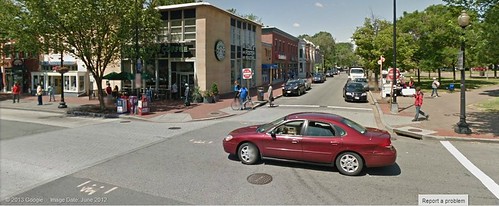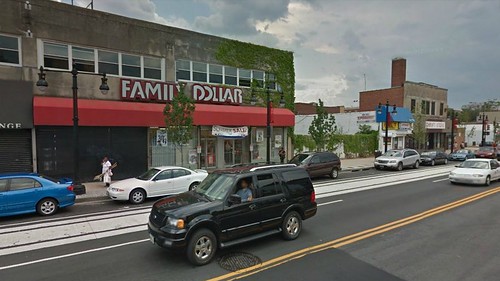If you want retail and you're not getting it, build your own (G.D.) systems to reproduce what you want
The title is in response to The Atlantic Cities piece "Retail Redlining: One of the Most Pervasive Forms of Racism Left in America?" and makes me think of my 2005 blog entries "Why the future of urban retail is not chains" and "Store Siting Decisions."
Chain retailers have very particular sets of criteria for opening up stores. And understandings of certain market segments which may or may not be correct.
Yes, this criteria is often out-of-step with reality. (But not always.)
 For example, the Starbucks at 8th and D Streets SE at the heart of the Eastern Market-Barracks Row interface is considered a low income store by Starbucks, so it was created in partnership with Magic Johnson's business of bringing retailers and restaurants to "underserved" communities.
For example, the Starbucks at 8th and D Streets SE at the heart of the Eastern Market-Barracks Row interface is considered a low income store by Starbucks, so it was created in partnership with Magic Johnson's business of bringing retailers and restaurants to "underserved" communities.Or the first "new" business on H Street after the release of the H Street master plan in 2003 was a Family Dollar store. No talk about hip and edgy back then. See "H Street NE: America's 6th-hippest hipster neighborhood, according to Forbes" from the Washington Post.

And last week, H Street NE won an award from the National Main Street Center as a "Great American Main Street" for 2013.
But the point I make in terms of the difference in comprehensive planning between "economic development" and "building a local economy" has to do with how much do you want to be dependent on chain retailers not based locally and mostly focused on repatriating profits to distantly-located headquarters.
For example, DC's focus on attracting Walmart has ignored the negative impact that can result on other retailers and commercial districts, their low rankings for customer service, and other problems--recently there have been many reports of out-of-stocks being the result of reducing labor as part of their ongoing focus on reducing costs ("Customers Flee Wal-Mart Empty Shelves for Target, Costco" from Bloomberg News).
Sure, they sell stuff for low prices, but is that the kind of business you want to be "anchoring" your community's retail offer?
My suggestion is to build the systems to develop and reproduce your own retail.
While that's tough for full-line department stores and discount categories, it's relatively easy for restaurants.
And if Olympia Fields outside of Chicago wants restaurants, that's what they should do.
Also see "Neighborhood Restaurant Initiative -- City of Boston -- and restaurant-driven revitalization," also from 2005 and writings on the relative failure of the Boulevard at Cap Centre in Prince George's County such as "Violence, Vacancies Trouble Md. Mall" from the Post.
Resources for Commercial District Revitalization
Note that N. David Milder's report on business recruitment, with a focus on attracting stores to low income and other challenging commercial district revitalization scenarios is EXCELLENT and the first thing that stakeholders in Olympia Fields, Illinois ought to be reading. It was a fundamental building block of my own learning on the subject.
After that, I recommend the ULI publication Ten Principles for Rebuilding Neighborhood Retail and the Downtown and the University of Wisconsin Extension program's Downtown and Business District Market Analysis Toolbox.
Those three items, plus a couple handbooks from the National Main Street Center, Fill in the Blank Business Recruitment and Marketing an Image for Main Street, although there are dozens and dozens more resources in the right sidebar, will get them well on their way.
Labels: commercial district revitalization, formula retail, retail entrepreneurship development



3 Comments:
in DC we need new government badly- there has been a taxation and anti business environment here for decades which was the result of " home rule" - a real shakedwon mentality has been at work against any new business- especially smaller businesses and individual afforts- business climate ratings routinely place DC dead bottom in the USA for trying to eradicate businesses. In retail - this is also huge problem in DC. Grays government is giving helpt to Sprawlmart and driving away small buisnesses - again smooching up to the big boys and killing everyone else. The city needs a giant buisness and taxation overhaul. We need to get Grays Junta out of office first.
What would be a positive solution to bringing revitalization to the areas of DC that borders PG County. Do you have any suggestions? I'd truly appreciate it. Thanks. (W7Cto20877)
I live in Oakland CA. Restaurants are opening weekly. But we have a ton of retail leakage, we don't have department stores. Or a conventional mall. Or even many chain stores. A Walmart. A shared Target. A Sears. A Home Depot. one Gap, one Foot Locker. I am happy we have become a foodie destination, but sometimes you need Macy's too. I don't know how. Any commercial districts we can sustain with cute vintage stores and wine shops.
Post a Comment
<< Home